

Śruti. Śhruti (Sanskrit: श्रुति, IAST: śrúti, lit.
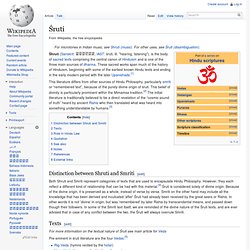
"hearing, listening"), is the body of sacred texts comprising the central canon of Hinduism and is one of the three main sources of dharma. These sacred works span much of the history of Hinduism, beginning with some of the earliest known Hindu texts and ending in the early modern period with the later Upanishads.[1] This literature differs from other sources of Hindu Philosophy, particularly smriti or “remembered text”, because of the purely divine origin of śruti.
This belief of divinity is particularly prominent within the Mimamsa tradition.[2] The initial literature is traditionally believed to be a direct revelation of the “cosmic sound of truth” heard by ancient Rishis who then translated what was heard into something understandable by humans.[3] Distinction between Shruti and Smriti[edit] Both Shruti and Smriti represent categories of texts that are used to encapsulate Hindu Philosophy. Rig Veda Index. Sacred Texts Hinduism Sanskrit Buy this Book at Amazon.com This is the Ralph T.H.

The Geography of the Rigveda. Chapter 4.

Sanskrit literature. The oldest surviving manuscript of the Devi Māhātmya, on palm-leaf, in an early Bhujimol script, Bihar or Nepal, 11th century.

Literature in Sanskrit begins with the Vedas, and continues with the Sanskrit Epics of Iron Age India; the golden age of Classical Sanskrit literature dates to late Antiquity (roughly the 3rd to 8th centuries AD). Literary production saw a late bloom in the 11th century before declining after 1100 AD. There are contemporary efforts towards revival, with events like the "All-India Sanskrit Festival" (since 2002) holding composition contests. Given its extensive use in religious literature, primarily in Hinduism, and the fact that most modern Indian languages have been directly derived from or strongly influenced by Sanskrit, the language and its literature is of great importance in Indian culture akin to that of Latin in European culture.
Indo-European Language Family Tree. Painted Grey Ware culture. Archaeological cultures associated with Indo-Iranian migrations (after EIEC).
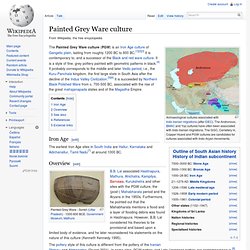
The Andronovo, BMAC and Yaz cultures have often been associated with Indo-Iranian migrations. The GGC, Cemetery H, Copper Hoard and PGW cultures are candidates for cultures associated with Indo-Aryan movements. The Painted Grey Ware culture (PGW) is an Iron Age culture of Gangetic plain, lasting from roughly 1200 BC to 600 BC.[1][2][3] It is contemporary to, and a successor of the Black and red ware culture. It is a style of fine, grey pottery painted with geometric patterns in black.[4] It probably corresponds to the middle and later Vedic period, i.e., the Kuru-Panchala kingdom, the first large state in South Asia after the decline of the Indus Valley Civilization.[5][6] It is succeeded by Northern Black Polished Ware from c. 700-500 BC, associated with the rise of the great mahajanapada states and of the Magadha Empire. Iron Age[edit] Overview[edit] B.B. See also[edit] References[edit] Bryant, Edwin (2001).
Kikkuli. Kikkuli, "master horse trainer (assussanni, virtually Sanskrit aśva-sana-) of the land Mitanni" (LÚA-AŠ-ŠU-UŠ-ŠA-AN-NI ŠA KUR URUMI-IT-TA-AN-NI) was the author of a chariot horse training text written in the Hittite language, dating to the Hittite New Kingdom (around 1400 BC).

The text is notable both for the information it provides about the development of Indo-European languages and for its content. Content and influence[edit] “Thus speaks Kikkuli, master horse trainer of the land of Mitanni” (UM.MA Ki-ik-ku-li LÚA-AŠ-ŠU-UŠ-ŠA-AN-NI ŠA KUR URUMI-IT-TA-AN-NI).[1] Sri Narasingha Chaitanya Ashram. Introduction The aryan invasion theory has been one of the most controversial historical topics for well over a century.
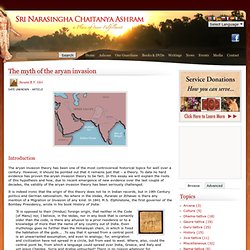
However, it should be pointed out that it remains just that – a theory. To date no hard evidence has proven the aryan invasion theory to be fact. Mycenaean Greek. Mycenaean Greek is the most ancient attested form of the Greek language, spoken on the Greek mainland, Crete and Cyprus in the 16th to 12th centuries BC, before the hypothesised Dorian invasion which was often cited as the terminus post quem for the coming of the Greek language to Greece.
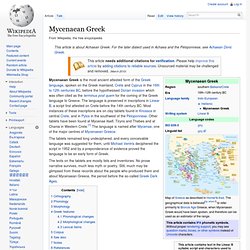
The language is preserved in inscriptions in Linear B, a script first attested on Crete before the 14th century BC. Most instances of these inscriptions are on clay tablets found in Knossos in central Crete, and in Pylos in the southwest of the Peloponnese. Other tablets have been found at Mycenae itself, Tiryns and Thebes and at Chania in Western Crete.[1] The language is named after Mycenae, one of the major centres of Mycenaean Greece. The tablets remained long undeciphered, and every conceivable language was suggested for them, until Michael Ventris deciphered the script in 1952 and by a preponderance of evidence proved the language to be an early form of Greek. Mitanni. Mitanni or Mittanni: ancient kingdom in modern Kurdistan, northern Iraq, and Syria, attested in the third quarter of the second milennium BCE.
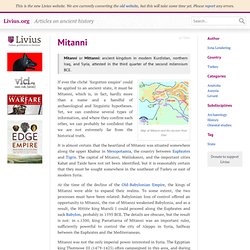
Map of Mitanni and the ancient Near East If ever the cliché "forgotten empire" could be applied to an ancient state, it must be Mitanni, which is, in fact, hardly more than a name and a handful of archaeological and linguistic hypotheses. Yet, we can combine several types of information, and where they confirm each other, we can probably be confident that we are not extremely far from the historical truth. Mitanni. Map of the Near East ca. 1400 BC showing the Kingdom of Mitanni at its greatest extent Mitanni (Hittite cuneiform KUR URUMi-ta-an-ni, also Mittani Mi-it-ta-ni) or Hanigalbat (Assyrian Hanigalbat, Khanigalbat cuneiform Ḫa-ni-gal-bat) or Naharin in ancient Egyptian texts was an Hurrian-speaking state in northern Syria and south-east Anatolia from ca. 1500 BC–1300 BC.
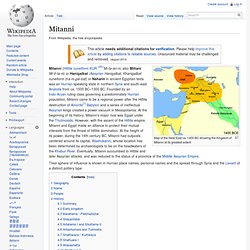
Founded by an Indo-Aryan ruling class governing a predominately Hurrian population, Mitanni came to be a regional power after the Hittite destruction of Amorite[1] Babylon and a series of ineffectual Assyrian kings created a power vacuum in Mesopotamia. Panini. From Wikipedia, the free encyclopedia Panini may refer to: People[edit] Pāṇini (fl. 4th century BCE), ancient Sanskrit grammarianGiovanni Paolo Panini (1691–1765), Italian artistA. R. Raja Raja Varma (1863–1918), Indian poet, grammatician, also known as Kerala PaniniCarlos Panini (died 1951), wealthy Mexican businessman of Italian originManuel Panini (born 1983), Italian footballer Other uses[edit] See also[edit]